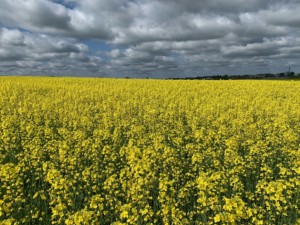 By Brian Caldbeck
By Brian Caldbeck
Consumer trends in recent years have resulted in retails sales of organic foods in the United States reaching $50 billion in 2020, according to the Organic Trade Association. Despite cooking oils derived from multiple crops, including canola, representing a tiny fraction of these sales, consumer interest in organic canola oil has encouraged the food industry to source organically produced canola from farmers.
The vast majority of canola produced in North America is grown using conventional farming practices, which employ synthetic fertilizers and crop production products to build economic yields and protect quality. In addition, the majority of this conventional canola is also genetically modified to confer herbicide tolerance to enable weed control. In recent years, biotech traits for pod shatter tolerance have been introduced into some canola cultivars to reduce field losses at harvest.
Organic canola production is entirely possible and offers a niche market opportunity for U.S. growers.
The remaining portion of conventionally produced canola represents an additional market segment from non-genetically modified (GM) seeds. Market share for this canola continues to expand due to premium prices and farmers are capitalizing on this opportunity without forfeiting productivity. In fact, in regions where winter canola is cultivated, the yields achieved from non-GM canola significantly outpace those of GM canola. These observations are verified by growers as well as public and private research entities.
 However, none of the above canola qualifies as organic, which precludes the use of synthetic fertilizer, crop protection products and GM seeds. General observations over several years have demonstrated that successful organic canola production is reliant on a combination of three main factors:
However, none of the above canola qualifies as organic, which precludes the use of synthetic fertilizer, crop protection products and GM seeds. General observations over several years have demonstrated that successful organic canola production is reliant on a combination of three main factors:
1) A significant premium over the price of conventional canola
2) Production located in regions where canola is not traditionally grown
3) Ample local supplies of animal manures and composts
Reviewing each of these factors individually provides insight into the contrasts of growing organic versus conventional canola.
Premiums on sales of organic crops, including canola, are a prerequisite to encourage farmers to enroll in organic certification programs. To achieve full organic status, a conventional farming operation must enter a three-year transition period that eliminates the use of synthetic chemicals, fertilizers and genetically modified seeds. Any crops produced through this transition period are not regarded as organic, thus, farm revenues through the period generally register significant declines with the aim to recoup these losses with sales of organic products once certification is complete. Official organic crops have reduced yields as well as increased management and labor costs without the use of synthetic nutrients and crop protection products so premiums for organic food and feed are necessary for economic sustainability.
Canola is well known as an attractive crop to the eye and this beauty extends to a host of both beneficial and pest species of insects. Experience has demonstrated that growing the crop in regions where canola is not common allows growers to avoid the worst impacts of insect pests. However, even in these regions, it is necessary to ensure wide intervals between successive crops and avoid the use of other common host crops in the rotation to counter buildup of damaging pests such as diamond back moths, flea beetles and cabbage seed pod weevils. New growing regions and extended rotational intervals for common host crops are also essential to curb the incidence of damaging fungal diseases like blackleg or sclerotinia, which are commonly observed in canola production.
 Adequate crop nutrition is fundamental for organic canola production. Canola has a relatively high demand for nutrients to support its extensive above and below ground biomass system, which is essential for the plant to produce energy-dense seeds with protein and oil content exceeding 20 and 40 percent, respectively. Local supplies of bulky animal manures and composts are excellent sources of these nutrients. Canola benefits from applications of these products while efficiently sequestering the abundance of contained nutrients to reduce their influx into groundwater and rivers.
Adequate crop nutrition is fundamental for organic canola production. Canola has a relatively high demand for nutrients to support its extensive above and below ground biomass system, which is essential for the plant to produce energy-dense seeds with protein and oil content exceeding 20 and 40 percent, respectively. Local supplies of bulky animal manures and composts are excellent sources of these nutrients. Canola benefits from applications of these products while efficiently sequestering the abundance of contained nutrients to reduce their influx into groundwater and rivers.
In conclusion, organic canola production is entirely possible and offers a niche market opportunity for U.S. growers. Its continued adoption and expansion is primarily dependent on consumer demand. Perhaps an unrecognized benefit of increased organic canola production is the increased research being performed by both private and public entities to solve challenges faced by growers. This research may lead to novel and sustainable solutions for weed, insect and fungal pests common in both organic and conventional canola crops.
Brian Caldbeck is an agricultural consultant and owner of Caldbeck Consulting in Philpot, Kentucky.